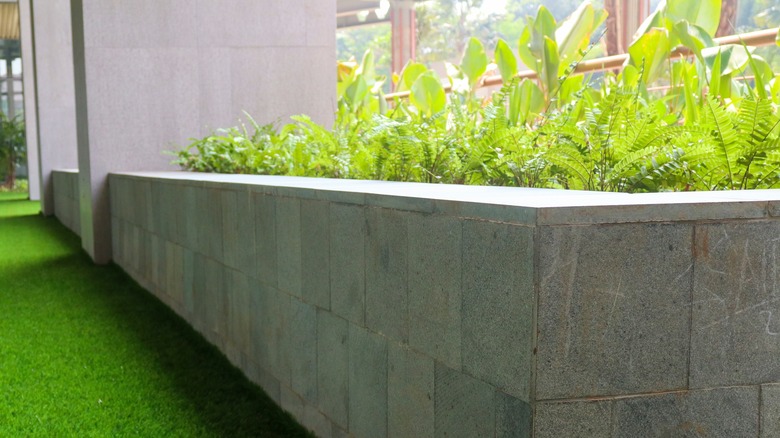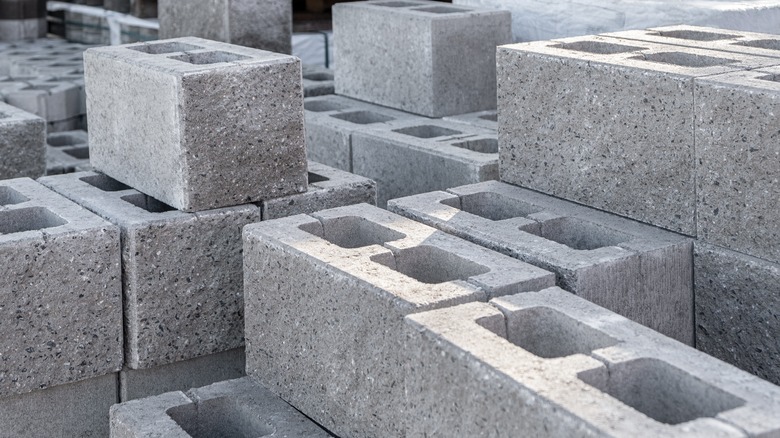Try TikTok's Cinder Block & Glue Raised Garden Bed For A DIY That Will Last
Landscaping projects like improving the raised plant beds in your garden or that adorn the lawn-abutting edges of your patio always seem daunting, both in relation to your budget and the skill set and tools required. Luckily, TikTok user @olivegreyave shared a surprisingly quick and easy DIY that's refreshingly approachable. Simply stack concrete blocks as high as you'd like them to go and top with concrete top caps as caps, gluing everything together with construction adhesive. Don't let the simplicity fool you; this raised bed is promised to last — with a few caveats.
Though the blocks themselves are said to hold up for a century or more, you need to put considerable effort into creating a completely level base layer and use a quality adhesive if you want to prevent the blocks from sinking. If you live in a damp climate or have a yard with poor drainage and don't want to go to the trouble of digging a foundation for the walls, this might not be the right project for you. Also, if you use cinder blocks, which often contain fly ash contaminated with heavy metals, or old, upcycled concrete blocks, it's suggested to avoid planting edibles in the raised beds. Newer concrete blocks (as opposed to the lighter cinder blocks) are often a safer option.
Get the foundations right
You can pick up new concrete blocks at most hardware stores for peanuts. For example, Lowe's sells standard dimension 8 by 8 by 16 inch concrete blocks for under $3 each. Before shopping, map out your raised bed on paper to determine how many you'll need. A raised bed with 8 by 8 by 16 inch blocks with two-layer walls and dimensions just under 5 feet wide by 9 feet long will require 36 standard dimension concrete blocks. Once that's put together, don't forget to top it off with concrete top caps.
The glue used in this TikTok DIY may not be strong enough to keep the blocks together long-term, is what caused some online users to disagree with the idea. But, if you invest in a heavy-duty construction adhesive, like masonry glue, this project will be a piece of cake, even for beginners. Compared with traditional mortar, this product — typically made of silyl-terminated polymer (STP) — is easy to apply and provides a bit of much-needed give, reducing the potential for the project cracking down the line. What's more, if you only build your walls two layers high, mortar isn't technically required at all. ACE Hardware has 9-ounce tubes of Gorilla heavy-duty construction adhesive for about $11.
Build your concrete block raised bed from the ground up
Tools-wise, you'll need a shovel, a hand-tamper, a level, a rubber mallet, a caulking gun, and thick gloves. Dig a trench 4 to 6 inches deep and fill that with pea gravel. Then, compact it with a tamper. Add the first layer of blocks, tapping them into place with the mallet. Getting this layer even is crucial, so use your level and don't rush.
Once everything's in place, glue your blocks together one at a time using the construction adhesive. Repeat the process for the successive layers, skipping the mallet. Top the walls with the flat pavers: either horizontally to cover the holes or vertically to create a planter. Leave the structure to cure for 24 to 72 hours, depending on what the construction adhesive is made of. To wrap up this ultimate guide to starting a raised bed garden, finish the exterior of the raised bed with stucco mix — if you don't want to see the lines of the blocks — or an outdoor paint — if you don't mind the joins. Using a polymer paint may help seal in any heavy metals the blocks harbor. Fill your planter with the three important soil ingredients you should use in a raised garden bed: topsoil, compost, and fertilizer.

